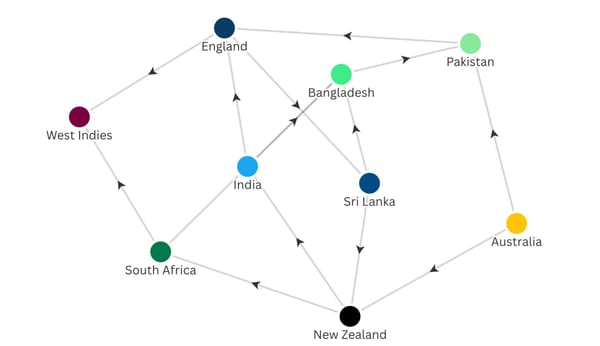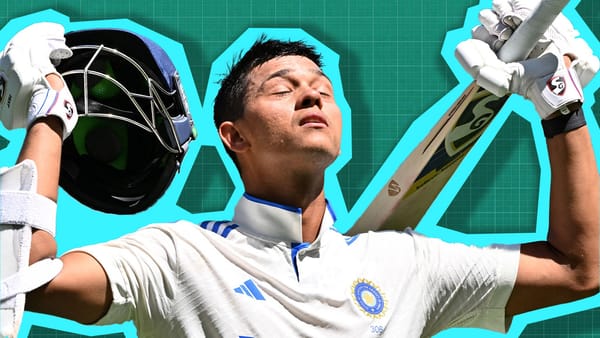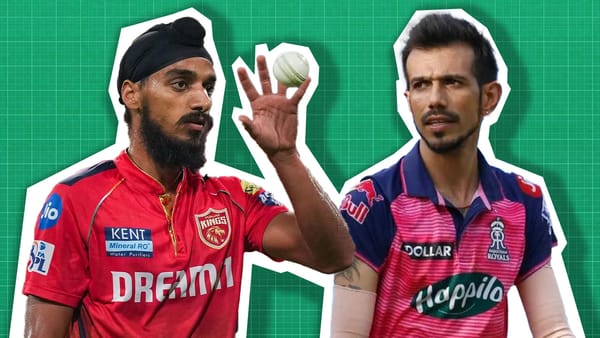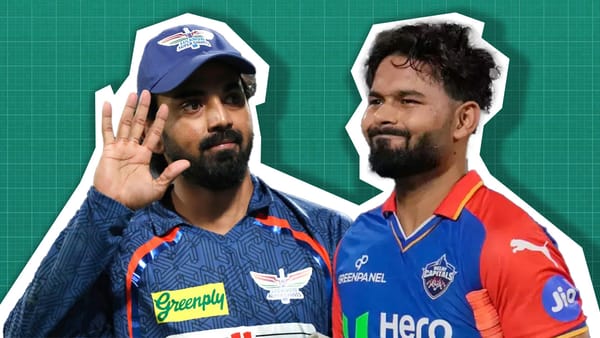One of the weirdest first class debuts ever
Australian Chris Green waited a lifetime to play Shield Cricket.
Trent Boult knocking back New Zealand's contract was treated as the beginning of the end of international and longer-form cricket. While it wasn't the first, because of Boult's Mumbai Indians background, it was seen as a sea change in cricket. And it got a lot of attention.
But something else happened recently that is worth noting. Chris Green made his debut in first-class cricket at the age of 29.

This is a list of all spinners who have delivered over 1000 balls in the powerplay. It's a fairly exclusive club. You probably know almost every name here. And you may know Chris Green, but only if you are Australian and love the Big Bash. Or you're a real T20 nerd.
He was born in South Africa but moved to Australia when he was still a kid. As a bowler, he never really fit into Australian thinking either. A defensive opening bowling off-spinner is not really in vogue there.
But he is terrific as a spoiler bowler. He has the ninth-best economy of the bowlers since 2014 with over 3000 balls.

And you might look at this and wonder why you don't know him. But for all the talk of people being smarter about T20, there is still a bias against some things in the market. And teams think they can find local finger spinners who can slow runs down.
Green has batting, but not enough to move the needle. The last five years, he's been good enough to at least moonlight as a number seven, but in the middle of that, he averaged seven one year.

So last two years he's averaged 16 while striking at 135. While he has shown glimpses of what he could do with the bat, it also doesn't inspire teams enough to see him as an all-rounder. But Green also has a third dimension; compared to most finger spinners he's an excellent fielder. In fact, compared to most players he is. He's a brilliant athlete, but again, it doesn't seem to have mattered that much.
But for a domestic player, that's a perfect combination. And because of that the Sydney Thunder gave him a six-year contract - the longest in the Big Bash. It is also just not the kind of thing we see in cricket. At this stage, he'd played two seasons in the CPL, once in the blast for Warwickshire and also a few PSL games. With good numbers, it looked like he was about to break out.
Less than two months later, he was called for throwing. It was probably an overdue call. As his action had deteriorated a fair bit. None of this is a surprise. His action was never that clean to begin with.
In fact, the two bowlers he was most compared to were Johan Botha and Sunil Narine. Both had their own issues with being called. The throwing call did dampen how teams thought of him, and more importantly, as you would expect, when he came back, his numbers weren't the same.

Although, weirdly, the numbers don't start straight away. He was called on 03 January 2020, and when he came back to bowl - in August of that year - he had good numbers that year. But since then, he has not been as good. He's still the same midlevel franchise player. Continuing to play in the CPL and the Blast. But he's just not as economical or striking as often.
This is the list of the most-used bowlers in T20 since his debut. Green is right up there with the best bowlers in terms of the economy rate.

And while he is very far from a strike bowler, this is the cluster you find bowlers like Axar Patel and R Ashwin.

But if you isolate his numbers in the last 2 years, the 25th most in cricket. And you can see he's now in the middle on economy, but his average has also jumped.
And so what you have at this point is an Australian spoiler offie who had been called for throwing, batted a little, and wasn't sexy. (As a cricketer, he's an extremely conventionally attractive man, though I haven't got stats for that). He was as boring as batshit to watch. He was the semi-skimmed milk of T20. And now his numbers were slipping.
Not enough to ruin his career, but perhaps enough to make him start to think about other options. And at this point, he was pretty much a full-time T20 player.
At one stage he played 126 straight T20 games without playing any other format. Yeah, that is some record. And really this is why I am talking about him now, it's because of this graph in front of you showing each format.

I tried to find another player with a similar record to this, it's not an easy thing to look up. And we have players later in their careers doing it, but not early. Nicholas Pooran was one I thought might be similar. Because he played three early first-class matches, and then had a falling out with Trinidad over his medical treatment.

But later on, he was good enough to play ODIs, and he even toyed with Tests when playing some four-day matches for West Indies A.

But compared to Pooran, Chris Green played 173 professional matches before he appeared in a first-class match. And you can see, really outside a few list A matches to start with, he wasn't even playing white ball cricket. There is usually a cross over there.
But the first-class thing is obviously the bigger issue. How was he this good and well-known and he didn't get a game at all, just to see if he could be handy?
One of the reasons is that New South Wales had a lot of spinners. Adam Zampa and Nathan Lyon both had to move to South Australia to get their big breaks. Zampa stayed, but Lyon came back and was obviously the first-choice off-spinner when available, which was a lot, as he doesn't play in Australia's white-ball plans. SteveO'Keefee was the other major spinner they used, so that is already two international finger spinners ahead of Green. But I can add another, New Zealand's Will Somerville played club cricket in Sydney and was also picked ahead of Green to bowl his off-spin.

The other truth is that the SCG doesn't spin like it once did. These are the Test numbers on this wicket looking at a five-game rolling average.

It is fair to say that the days of picking two spinners there automatically are well gone.
It was really 2016/17 when Green was a dead certainty to be picked by Sydney Thunder with two strong years under his belt. The following year he took 23 wickets at 21. But the problem now was he didn't play that much two-day grade cricket.

Other than the one year he took three wickets at 50, which is a pretty small sample size anyway. But he also only took 53 wickets over five years, and in those, he averaged low 20s. It would have garnered more attention if he had taken more wickets at that mark.
But he was typecast, didn't play, or couldn't beat the international finger spinners for a spot. To be fair, if you just looked at him bowl, he doesn't really look like the sort who would be a good first class.
In 2015 and 18 he played second-XI red ball cricket with Surrey. In 2021, he played another game for Middlesex. And he has at times - when not playing in Canada or the Caribbean played English club cricket. It's not the way potential first-class spinners usually prepare.
And so Chris Green played 173 matches of white ball cricket, and then suddenly, New South Wales selected him for his debut first-class match when Adam Zampa was playing ODIs, Nathan Lyon was being rested and Tanveer Sangha was injured.
And like most cricketers of his age - 29 - he didn't grow up wanting to be a franchise t20 player. He was ten when T20 started. He would have dreamt of a baggy green or canary yellow strip.
He became a T20 player because he was good at it and because once he did that, he didn't look like a red ball player, or have time to pursue it. But over the last few years, he hasn't become an IPL, PSL or Hundred stalwart, and so for him, first-class cricket is still going to pay well. At the least, it gives him other professional offers if the T20 doesn't work.
Remember all this happened the same year Trent Boult resigned from his New Zealand contract so he could work directly with the many franchises Mumbai India have and will buy. That was seen as the beginning of the end for many.
Yet it wasn't mentioned when Chris Green suddenly changed his career arc 173 matches into his pro-life. Now that does make sense at a certain level, even though I still struggle with Green's name, so his choice in the other direction was never going to make big news.
But what it tells us is that for mid-level players who don't get huge contracts, or the ability to hop around Ambani-owned teams, the allure of freelance is still not that strong. Things like insurance and medical care are much easier with a contract. Getting access to high-quality practice wickets, coaches, physios, analysts, videos and dieticians. If you are freelance, this is all on you - like a golfer or tennis player. And so many players don't go freelance until they are at the Andre Russell level.
And Green has said he wants an NSW deal. And at his level, he is unlikely to get the money or multiple longer-term contracts - outside of home leagues - and so it makes sense to keep a backup plan going.
Players will go where the money is, and they will also adapt to make more money in their careers. The weird thing is Chris Green did that, but the opposite of the current narrative.
Right now he is back in the Big Bash, being all economical and stuff. But you probably just want to know what happened when he actually played first-class cricket.
Well, Chris Green was the Player of the Match on debut, with nine wickets. That included the wickets of Bancroft, Cartwright and Philippe in the first innings, three internationals. He was worth the wait it would appear. In the next game, he added another three wickets from limited opportunities.
It would appear he was worth the wait.




